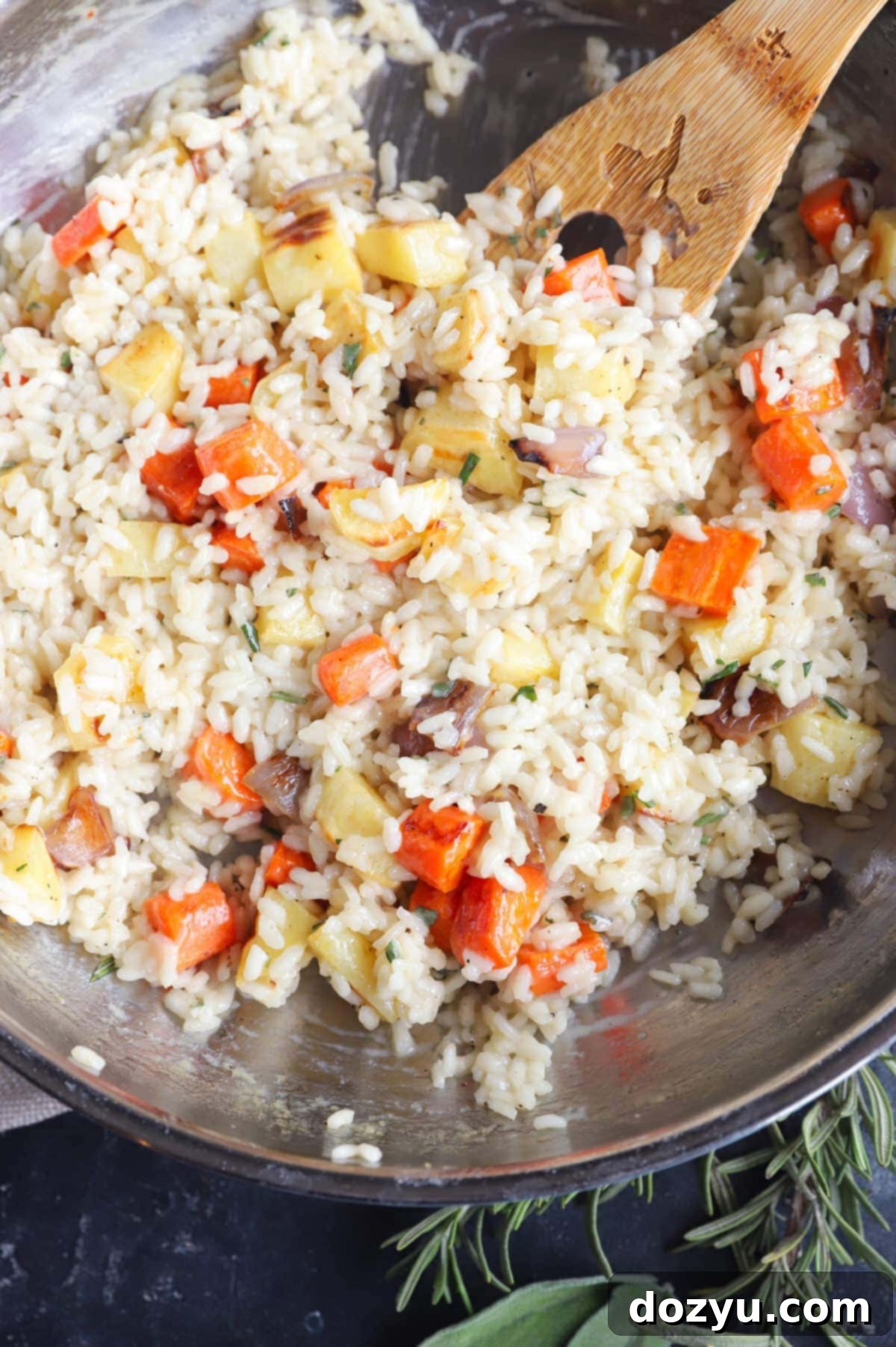Ultimate Winter Roasted Vegetable Risotto: Your Go-To Creamy Comfort Meal
Indulge in the rich, comforting flavors of our Winter Roasted Vegetable Risotto, a dish perfectly crafted for those chilly evenings when you crave warmth and deliciousness. This luxurious yet surprisingly easy meal is a culinary embrace, designed to bring joy and satisfaction. Whether you’re gathering the family for a hearty dinner, serving it as a refined side alongside a perfectly cooked steak or tender roasted chicken, or planning an intimate date night with a fine bottle of red wine, this risotto is an absolute must-try for the winter season. Designed to serve four, it promises a memorable dining experience.
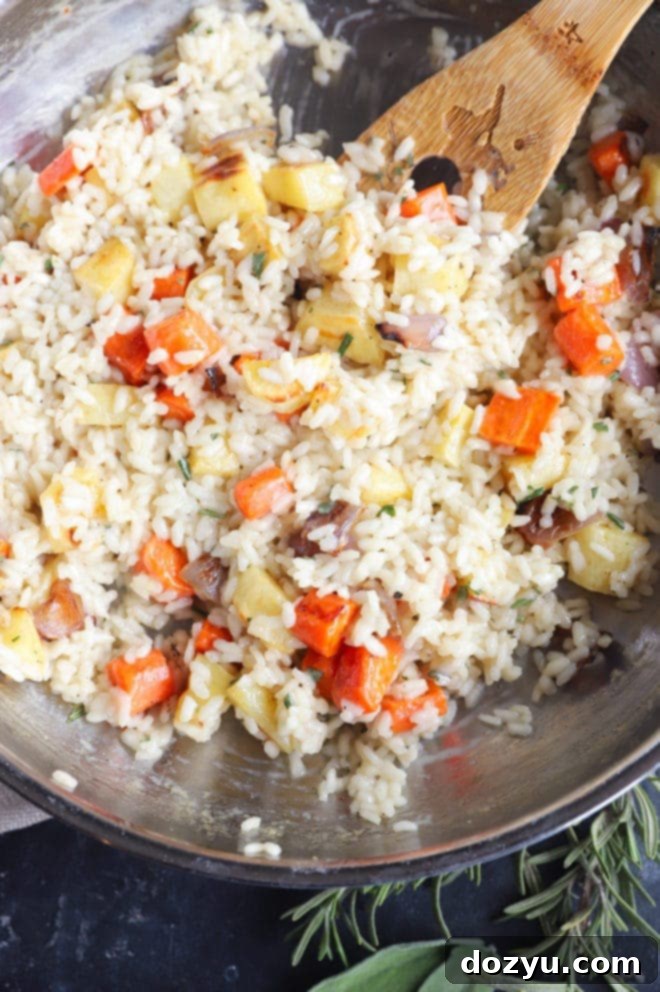
For me, risotto has always been more than just a meal; it’s a delightful ritual. It embodies a touch of luxury that feels wonderfully attainable right in my own kitchen. This particular recipe holds a special place in my heart, as it’s one of those rare dishes that encourages you to slow down, savor the process, and truly enjoy the therapeutic pleasure of cooking.
Imagine standing by the stove, a gentle warmth emanating from the bubbling risotto, a glass of your favorite wine or a refreshing cocktail in hand. You’re lazily stirring, watching the Arborio rice slowly transform, absorbing the rich stock and swelling into a creamy, luscious texture. It’s a moment to truly unwind. I often use this time to put on a comforting show on my iPad or catch up on a favorite podcast, letting the rhythmic stirring transport me away from the daily hustle.
In essence, preparing this winter roasted vegetable risotto is a cherished opportunity to decelerate. In the whirlwind of life, especially while raising a toddler, these moments of focused, enjoyable cooking are invaluable. Each perfect bite of this creamy, earthy, and slightly sweet roasted vegetable risotto offers a harmonious blend of tender, caramelized vegetables and rich, al dente rice. There’s no need to reserve this exquisite dish for a special occasion; its comforting flavors and effortless elegance make it an ideal candidate for a regular seasonal favorite that your family will look forward to.

Why You Will Love This Risotto
This Winter Roasted Vegetable Risotto isn’t just a meal; it’s an experience. Here’s why it deserves a spot in your winter recipe rotation:
- Unbeatable Comfort: The creamy texture and warm, earthy flavors are the epitome of comfort food, perfect for warding off the winter chill.
- Bursting with Flavor: Roasting the vegetables intensifies their natural sweetness and creates a depth of flavor that sautéing simply can’t achieve. This, combined with fragrant herbs and savory stock, makes every spoonful a delight.
- Simple Elegance: Despite its luxurious feel, this risotto recipe is incredibly straightforward to follow, making it accessible for home cooks of all skill levels. It looks impressive but requires minimal fuss.
- Versatile Dining: Whether you need a hearty vegetarian main course, a sophisticated side dish for meat or fish, or a cozy meal for a quiet night in, this risotto fits every occasion.
- Meditative Cooking: The process of slowly stirring the risotto is surprisingly calming and enjoyable, turning meal preparation into a mindful activity.
The Star Ingredients for Your Winter Risotto
Each component of this risotto plays a vital role in creating its balanced and rich flavor profile. Choosing quality ingredients will elevate your dish to new heights.
- Parsnip: Often overlooked, this root vegetable is a distant cousin to the carrot, offering a unique, slightly sweet, and nutty flavor with delightful earthy undertones when roasted. It adds a wonderful depth that truly defines this winter risotto.
- Carrot: The humble carrot, a staple in many kitchens, shines when roasted. Its natural sugars caramelize, enhancing its sweetness and providing a vibrant color and satisfying texture. For a fun twist or if you prefer, consider substituting with cubed butternut squash for a similar sweet and earthy profile.
- Red Onion: The sharpness of red onion mellows into a beautiful sweetness when roasted, creating a perfect counterbalance to the other root vegetables. If red onion isn’t available, white onion is a good alternative, and yellow onion can also be used in a pinch, though it might offer a slightly less sweet roasted flavor.
- Chicken or Vegetable Stock: This is the backbone of your risotto’s flavor. Using a high-quality chicken or vegetable stock (or broth) imparts a much richer and more complex taste than water ever could. It’s crucial to warm your stock before adding it to the rice, as this helps maintain a consistent cooking temperature and promotes even absorption.
- Garlic: A foundational aromatic, garlic provides a pungent, savory base. While mincing fresh garlic offers the strongest flavor, don’t hesitate to use good quality pre-minced garlic from a jar for convenience. It’s a fantastic time-saver and spares your hands from lingering garlic scent!
- Arborio Rice: This is arguably the most critical ingredient for any traditional risotto. Arborio rice is a medium-grain rice with a high starch content, which is essential for achieving that characteristic creamy texture. While other long-grain rices can be used for rice dishes, they lack the specific starch properties needed for true risotto and require different liquid ratios, making Arborio rice the non-negotiable choice for this recipe.
- Fresh Herbs (Sage & Rosemary): These fresh herbs are truly the secret to unlocking a delightful wintery essence in your risotto. Their robust, aromatic notes of sage and rosemary perfectly complement the roasted vegetables and creamy rice, adding a sophisticated layer of flavor. Thyme or basil can also be wonderful additions or substitutions if you prefer a different herbaceous twist.
- Parmesan Cheese: Freshly grated Parmesan cheese is essential for imparting a salty, umami-rich depth and contributing to the risotto’s luxurious creaminess.
- Butter: Added at the very end, a knob of unsalted butter melts into the risotto, creating an incredibly silky, rich, and glossy finish that is characteristic of a perfectly made risotto.
- Olive Oil, Salt, and Black Pepper: These pantry staples are crucial for roasting the vegetables, building the risotto base, and seasoning the dish to perfection.
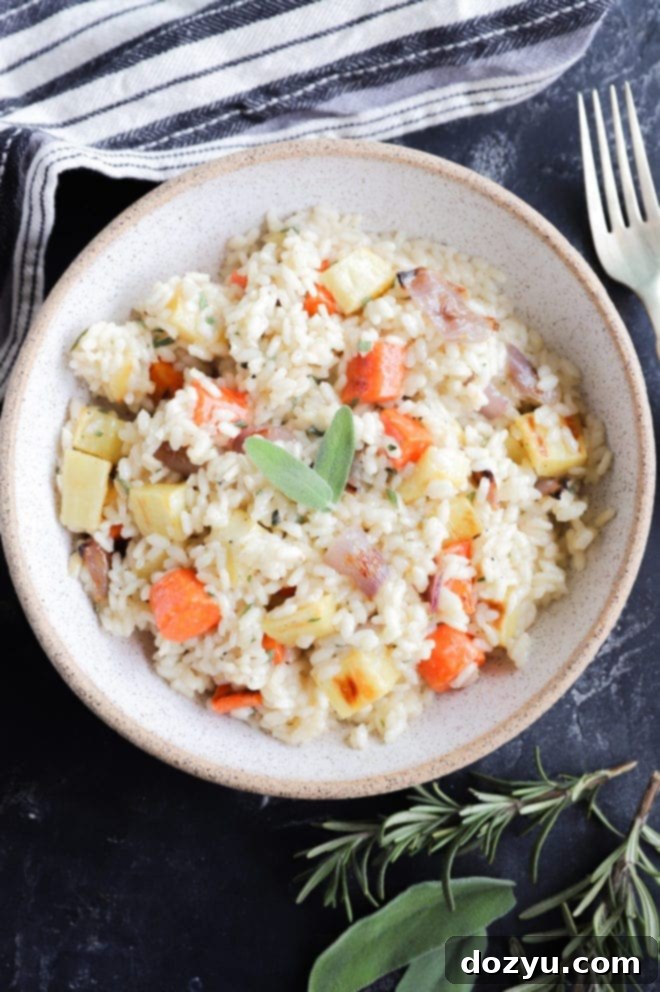
Essential Tools for Risotto Making
Having the right tools can make the risotto-making process even more enjoyable and efficient. You don’t need a gourmet kitchen, but these items will certainly help:
- Cutting Board & Chef’s Knife: Essential for prepping all your vegetables and herbs. A sharp chef’s knife makes chopping effortless and safe.
- High-Sided Skillet or Dutch Oven: A large skillet with tall sides (or a Dutch oven) is ideal for cooking risotto. Its ample surface area allows for even evaporation and stirring, while the high sides prevent the creamy rice from splattering all over your stove. My nonstick 12-inch skillet works wonderfully for this recipe, and is even large enough to double the batch if you’re feeding a bigger crowd!
- Wooden Spoon: For all the stirring that risotto requires, a sturdy wooden spoon is a must. It won’t scratch your nonstick pans and provides a comfortable grip. I personally love a durable wooden spoon that has stood the test of time in my kitchen.
- Baking Sheet with Parchment Paper/Silicone Mat: Needed for roasting your vegetables evenly and preventing sticking.
- Small Saucepan: For warming your stock before adding it to the risotto. This might seem like a small detail, but it’s key for maintaining an even cooking temperature and achieving that perfect creamy consistency.
Investing in a few quality kitchen essentials can truly transform your cooking experience, making complex dishes like risotto feel approachable and fun.
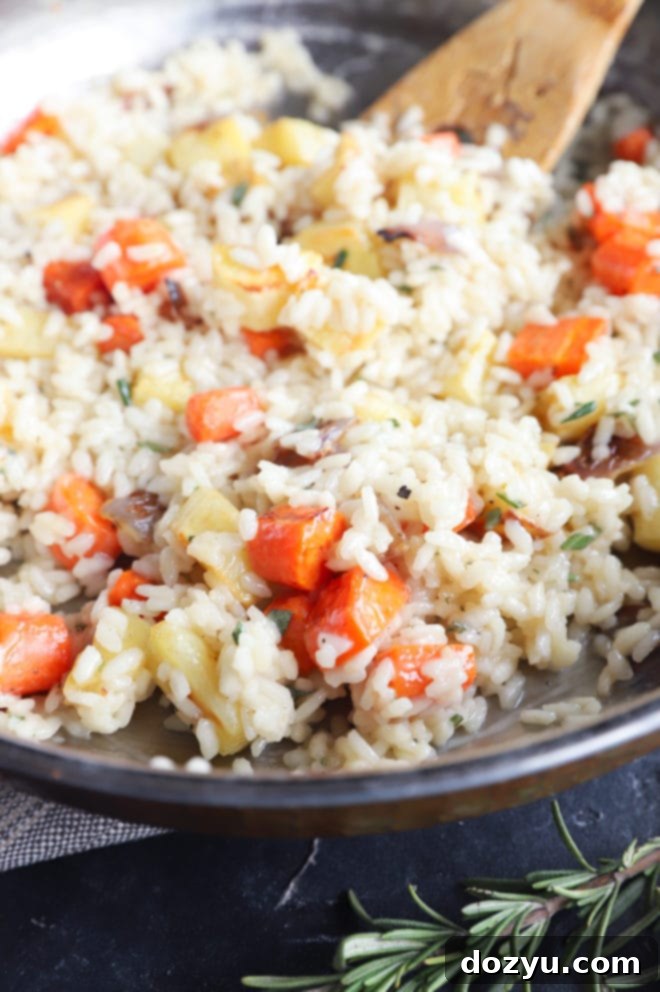
Crafting Your Creamy Winter Roasted Vegetable Risotto: A Step-by-Step Guide
Making risotto is a process of patience and love, but the results are incredibly rewarding. Follow these steps for a perfect, comforting dish:
Step 1: Roasting the Winter Vegetables to Perfection
Begin by preheating your oven to 400˚F (200˚C). Line a large baking sheet with parchment paper or a silicone mat to prevent sticking and ensure easy cleanup. In a spacious bowl, combine your peeled and cut parsnips, carrots, and red onion with 2 teaspoons of olive oil. Toss them gently to ensure they are evenly coated, then season generously with salt and freshly ground black pepper. Spread the seasoned vegetables in a single layer on the prepared baking sheet. Roast in the preheated oven for approximately 15 to 20 minutes, or until they are tender and slightly caramelized at the edges. Once done, remove them from the oven and set aside; their deep, sweet flavor will be a delightful addition to your risotto.
Step 2: Building the Risotto Base – Toasting the Arborio Rice
Before you even begin with the rice, heat your chicken or vegetable stock in a small saucepan over medium-low heat. The stock should be warm, but not boiling, as adding cold liquid to hot rice will shock it and hinder the release of starches. This warm stock is absolutely vital for maintaining a consistent temperature throughout the cooking process. Now, in your large, high-sided skillet (or Dutch oven) over medium heat, add 1 tablespoon of olive oil. Once shimmering, add the minced garlic and cook for about 30 seconds to 1 minute, until it becomes fragrant and lightly golden – be careful not to burn it! Stir in the Arborio rice and toast it for about 2 minutes, stirring occasionally. This toasting process, known as “tostatura,” lightly browns the grains, enhancing their nutty flavor and helping them retain their shape during the slow cooking.
Step 3: The Art of the Stir – Gradual Liquid Absorption
Pour in the dry white wine and bring it to a gentle simmer. Continue stirring until the wine has been almost entirely absorbed by the rice, leaving behind its delicate flavor. Next, begin adding the warmed stock, one cup at a time. Pour in the first cup, and stir frequently. The key to creamy risotto is this continuous (but not constant) stirring, which gently abrades the rice grains, encouraging them to release their starches into the liquid. As the rice absorbs each cup of stock and the mixture thickens to a creamy consistency, add the next cup. Repeat this patient process, adding one cup of stock at a time and stirring, until the rice is cooked through to a perfect al dente – tender with a slight bite in the center. This usually takes approximately 25 to 35 minutes in total. Remember, you might not need to use all the stock; always taste-test the rice between additions to check for doneness and adjust liquid as needed. The final texture should be creamy and flowing, not stiff.
Step 4: The Luxurious Finish – Creaminess and Flavor Infusion
Once the rice has reached its ideal al dente texture, remove the skillet from the heat. Stir in the grated Parmesan cheese and butter vigorously until both are completely melted and integrated, creating a wonderfully creamy, glossy texture known as “mantecatura.” This step is crucial for achieving that signature rich and smooth finish. Gently fold in the fresh chopped herbs, sage and rosemary, which will infuse the risotto with their aromatic wintery essence. Finally, add the previously roasted parsnips, carrots, and red onion, stirring gently to combine them throughout the creamy rice. Taste the risotto and season with additional salt and black pepper as needed. Serve immediately, perhaps with an extra sprinkle of Parmesan and a few fresh herb sprigs for garnish, and enjoy this incredibly satisfying winter meal!

Pro Tips for Achieving Risotto Perfection
While making risotto is a straightforward process, a few key techniques can elevate your dish from good to absolutely sublime:
- Stir Regularly, But Don’t Obsess: Consistent stirring is paramount. It’s what encourages the Arborio rice to release its starches, creating that signature creamy texture. You don’t need to stir every single second, but regular, gentle stirring (every 30-60 seconds) is a must. This allows you to witness the magical transformation of the rice grains and ensures even cooking. As mentioned earlier, I find this rhythm quite meditative – a perfect time to listen to a podcast or a favorite album.
- Warm Stock is Your Best Friend: Never add cold stock to your hot rice. Warming your chicken or vegetable stock in a separate saucepan before adding it to the risotto prevents temperature fluctuations, which can shock the rice and hinder its ability to absorb liquid and release starch smoothly. Keeping the stock warm ensures a continuous, even cooking process.
- Add Liquid Gradually, Not All at Once: The “one cup at a time” rule is non-negotiable for risotto. Allow each addition of warm stock to be almost fully absorbed by the rice before adding the next. This controlled hydration is key to building layer upon layer of creamy texture and ensures the rice cooks perfectly al dente, without becoming mushy or gluey.
- Don’t Skip the Butter and Parmesan at the End: This final step, known as “mantecatura,” is absolutely critical for the perfect risotto. Stirring in that knob of butter and generous amount of freshly grated Parmesan cheese at the very end melts into the rice, creating an incredibly rich, velvety, and glossy finish. It adds a depth of flavor and a luxurious mouthfeel that truly completes the dish. Trust me, the small amount of fat is worth every single glorious bite!
- Taste Test Frequently: Your palate is your best guide. Taste the rice regularly towards the end of the cooking process to check for doneness (al dente!) and to adjust the seasoning. This ensures your risotto is perfectly seasoned and cooked to your preferred texture.
- Use a Good Quality White Wine: The wine adds a subtle acidity and complexity that brightens the overall flavor of the risotto. Choose a dry white wine you would enjoy drinking, like a Chardonnay (as used in this recipe), Sauvignon Blanc, or Pinot Grigio. If you prefer not to use alcohol, simply increase the amount of stock by one cup.
Frequently Asked Questions About Risotto
Why Oven Roast Instead of Sautéing the Vegetables?
The decision to oven roast the vegetables for this risotto is a deliberate one, driven by flavor. Oven roasting caramelizes the natural sugars in the parsnips, carrots, and onions, yielding a much deeper, sweeter, and more complex flavor profile than simply sautéing them. This intense flavor perfectly complements the creamy richness of the risotto. Furthermore, it’s a wonderfully efficient method; while you’re patiently stirring the risotto on the stovetop, your vegetables can be roasting away in the oven, saving you time and freeing up burner space. However, if you are truly pressed for time, sautéing the vegetables in a little olive oil until tender is an acceptable alternative, though you will notice a difference in the depth of flavor.
Can I Use Other Roasted Vegetables in This Recipe?
Absolutely! This recipe is incredibly versatile and encourages you to experiment with other seasonal vegetables. Many winter root vegetables and hearty greens can be swapped in or added to the mix. Consider:
- Beets: These add a gorgeous earthy sweetness. Be mindful that red beets will impart a lovely, but distinct, pink hue to your creamy risotto!
- Broccoli or Brussels Sprouts: Roasting these brings out their nutty flavors and tender-crisp textures.
- Cauliflower: Roasts beautifully, becoming sweet and slightly smoky.
- Potatoes or Sweet Potatoes: Cubed and roasted, these add a substantial, comforting element.
- Turnips or Winter Squash (e.g., acorn, delicata): Offer delightful sweetness and texture.
Just ensure all vegetables are cut into similar-sized pieces for even roasting and adjust roasting times if needed, as some vegetables may cook faster or slower than others.
Is this recipe vegetarian? Can I make it vegan?
As written, this recipe is vegetarian, provided you use vegetable stock instead of chicken stock. To make it entirely vegan, you would need to make a few substitutions:
- Stock: Use vegetable stock.
- Butter: Replace with a good quality plant-based butter or additional olive oil.
- Parmesan Cheese: Use a dairy-free Parmesan alternative. There are many excellent options available on the market today that melt beautifully.
With these simple swaps, you can enjoy a delicious and creamy vegan winter roasted vegetable risotto!
What kind of wine should I use?
For risotto, a dry white wine is preferred. This means a wine that is not sweet. Good choices include Chardonnay (unoaked), Sauvignon Blanc, Pinot Grigio, or even a dry Vermouth. The wine adds a pleasant acidity and complex flavor notes that enhance the overall dish. Use a wine you would enjoy drinking, as its flavor will concentrate in the risotto. If you prefer not to use wine, simply substitute with an equal amount of additional vegetable or chicken stock.
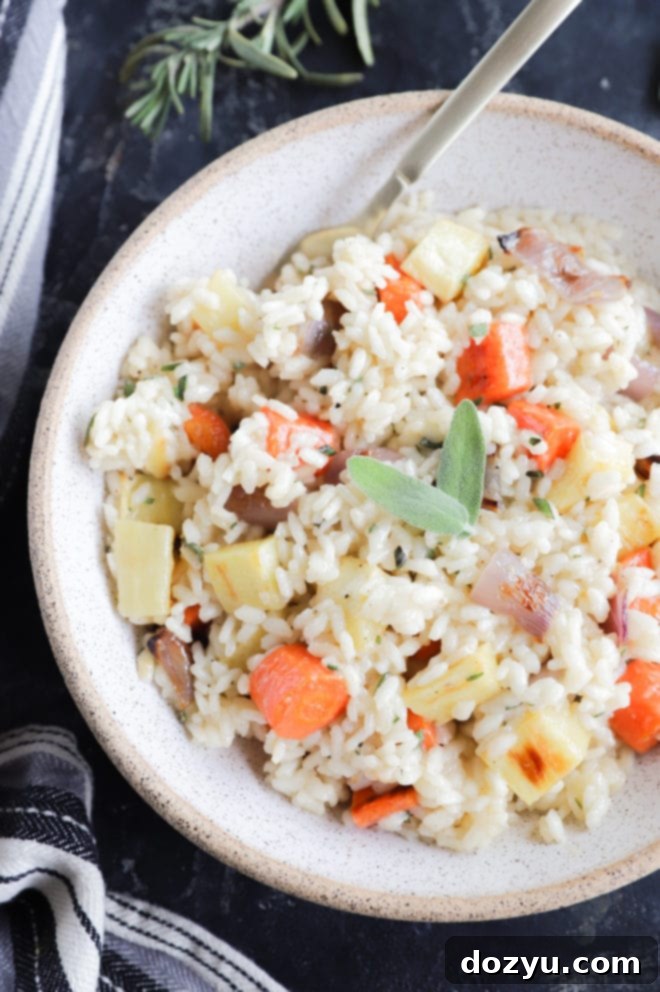
Serving Suggestions: What Pairs Beautifully with This Risotto
This Winter Roasted Vegetable Risotto is substantial enough to be a fantastic vegetarian main course on its own, especially when served with a fresh green salad and some crusty bread. However, its rich and savory profile also makes it an exceptional side dish that complements a variety of proteins. Here are some inspired pairings:
- Roasted Chicken with White Wine and Herbs: The delicate flavors of a roasted chicken, infused with white wine and aromatic herbs, create a harmonious and elegant meal alongside this creamy risotto. The cooking times can often be coordinated, making it a surprisingly easy pairing for a more elaborate dinner.
- Lemon Baked Salmon: For seafood lovers, the bright, fresh notes of lemon baked salmon provide a wonderful contrast to the earthy richness of the risotto. This is a convenient option as the salmon can be baked in the oven while you attend to the risotto on the stovetop, ensuring a fresh and flavorful meal with minimal fuss.
- Chili Coffee Rubbed Steak: For those who enjoy bold flavors, a robustly seasoned chili coffee rubbed steak offers an exciting depth that stands up beautifully to the creamy risotto. The smoky, slightly spicy notes of the steak create a dynamic and memorable culinary experience when paired with the sweet, savory vegetables and rice.
- Grilled Pork Tenderloin: A simply grilled or pan-seared pork tenderloin, perhaps with a light herb sauce, would also make a lean yet satisfying accompaniment.
- A Simple Green Salad: Sometimes, the best accompaniment is a light and refreshing side. A crisp green salad with a bright vinaigrette helps cut through the richness of the risotto, offering balance to your meal.
Storing and Reheating Leftover Risotto
Risotto is best enjoyed fresh off the stove, when its creamy texture is at its peak. However, if you do have leftovers, they can be stored and reheated with a few simple tips:
Cool the risotto completely before transferring it to an airtight container. Store it in the refrigerator for up to 2 days. It’s important to note that risotto does not freeze well; the rice grains can become mushy and lose their ideal texture upon thawing, so it’s best to avoid freezing.
To reheat, spoon the desired portion of risotto into a microwave-safe bowl or a small saucepan over low heat. Add about 1 tablespoon of unsalted butter and a splash of white wine or chicken stock (approximately 1/4 to 1/2 cup per serving). The extra liquid is crucial because the rice will have absorbed much of the moisture during refrigeration, and the butter will help restore its creamy consistency. Microwave on medium power for 2-3 minutes, stirring halfway through, or gently heat on the stovetop, stirring frequently, until warmed through. Add more liquid as needed to achieve your desired creamy consistency. Taste and adjust seasoning before serving.
Frequently Asked Questions About Risotto
For even more in-depth knowledge and answers to all your risotto-related questions, I highly recommend checking out my comprehensive How to Make Risotto post. It covers everything from ingredient modifications to troubleshooting common issues, including why I generally don’t recommend using just water instead of flavorful stock (lol!). It’s a fantastic resource for mastering the art of risotto.
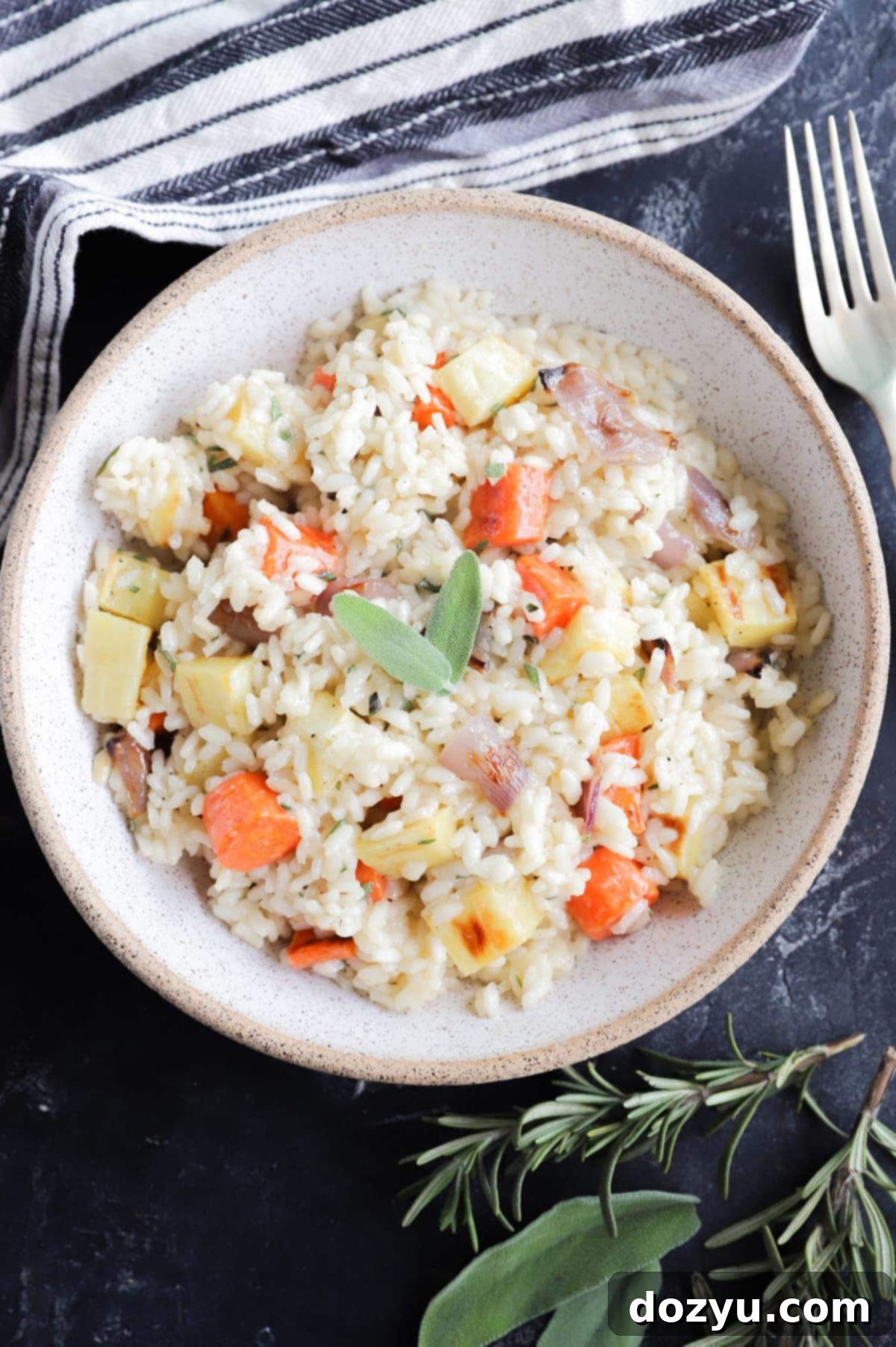
Winter Roasted Vegetable Risotto
A simple white wine risotto featuring tender roasted winter vegetables is a delightful and comforting meal perfect for chilly days.
Prep Time: 10 mins
Cook Time: 35 mins
Total Time: 45 mins
Servings: 4
Pin Recipe
Equipment
- Shun Classic Western Chef’s Knife, 8-Inch
- Utility Cutting Board
- Wooden Spoon & Scraper
- Nonstick 12-Inch Skillet
Ingredients
- 1 Tbsp + 2 tsp olive oil
- 1 large parsnip, peeled and cut into 1/2-inch pieces
- 2 to 3 carrots, peeled and cut into 1/2-inch pieces
- 1/2 red onion, peeled and cut into 1-inch pieces
- 3 cups chicken stock (or vegetable stock for vegetarian option)
- 2 garlic cloves, minced
- 1 cup arborio rice
- 1 cup dry white wine (e.g., Chardonnay)
- 1/4 cup grated parmesan cheese
- 1 Tbsp butter
- 1 tsp freshly chopped sage
- 1 tsp freshly chopped rosemary
- Salt and pepper to taste
Instructions
- Preheat oven to 400˚F (200˚C). Line a baking sheet with parchment paper or a silicone mat.
- In a medium saucepan, bring the chicken stock for the risotto to a gentle simmer; cover and keep warm over low heat.
- In a large bowl, add parsnip, carrots, and red onion with 2 tsp olive oil. Season with salt and pepper. Spread evenly on the prepared baking sheet and roast until tender and slightly caramelized, about 15 to 20 minutes. Remove from oven and set aside.
- While the vegetables are roasting, in a large high-sided skillet, heat 1 Tbsp olive oil over medium heat. Add the minced garlic and cook until fragrant and lightly browned, about 1 minute. Stir in the Arborio rice and toast for 2 minutes, stirring occasionally. Add the white wine and simmer, stirring, until almost completely absorbed.
- Pour in approximately 1 cup of the hot stock. Cook, stirring frequently, until the stock has been almost entirely absorbed by the rice. Repeat this process, adding 1 cup of stock at a time and stirring constantly, until the rice is tender and creamy with a slight bite (al dente). You may not need all the stock, so taste the rice between each addition. This step should take approximately 25 to 35 minutes in total.
- Remove the skillet from the heat. Stir in the grated Parmesan cheese and butter until both are melted and the risotto is wonderfully creamy. Fold in the roasted vegetables and fresh herbs. Season with additional salt and pepper to taste. Serve immediately and enjoy!
Nutrition
Calories: 487kcal | Carbohydrates: 59g | Protein: 11g | Fat: 22g | Saturated Fat: 5g | Polyunsaturated Fat: 2g | Monounsaturated Fat: 13g | Trans Fat: 0.1g | Cholesterol: 18mg | Sodium: 421mg | Potassium: 534mg | Fiber: 4g | Sugar: 7g | Vitamin A: 5243IU | Vitamin C: 11mg | Calcium: 100mg | Iron: 3mg
Cuisine: Italian | Category: Main Dish
